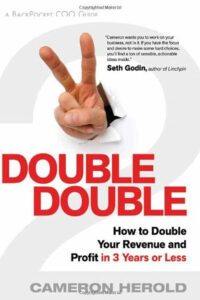Humility is not a trait we often associate with being a CEO, but it is necessary to be able to have the kind of relationship with your trusted COO to say, “Hey, I’m not strong in this area, can you help?” Having that level of trust is a vital component of the CEO/COO relationship. In today’s episode, Cameron offers some thoughts on the yin and yang of the CEO and COO, and why so many entrepreneurs are on the spectrum for bipolar disorder. He also discusses why behavioral traits and skill sets are different for every role, a fact which needs to be considered when interviewing.
Share This Episode On:
In This Episode You’ll Learn:
- The two-in-a-box approach to the CEO/COO relationship.
- Why turbulence in a company can be destructive to the culture.
- Why the CEO needs to have a safe place to talk about their fears and insecurities.
- And much more!
Resources:
Connect with Cameron: Website | LinkedIn
Get Cameron’s latest book: The Second in Command – Unleash the Power of Your COO
Subscribe to our YouTube channel – Second in Command Podcast on YouTube
Get Cameron’s online course: Invest In Your Leaders
—
In this episode, we’re diving into a topic that challenges the conventional perception of CEOs. We often don’t associate humility with being a CEO but it’s a crucial trait when it comes to building a strong and trusting relationship with your Chief Operating Officer, COO. Imagine being able to turn to your trusted COO and say, “I need help in this area. Can you lend a hand?” That level of trust is vital in the CEO-COO dynamic.
Here, I share insights on the fascinating yin and yang of the CEO and COO relationship and the importance of understanding that each role requires different behavioral traits and skillsets. This awareness becomes particularly crucial during the interviewing process to ensure the right fit for the team. If you’re curious to explore the unexpected dynamics between CEOs and COOs and how humility and trust play a pivotal role, this episode is a must-read.
—
The core values are going to be the same but the way that we show up as individuals might be slightly different. What matters to us is going to be the same. That’s the key salient point. I always say we have to interview for core values, behavioral traits, and proven skillsets on a role-by-role basis. If you’re looking for the second in command, what are those? Core values don’t change across any role in the company but the behavioral traits and the skillsets change for every role in the company.
There’s something in this at its core. It requires a level of humility by the founder or the leader to complete this activity inventory checklist and be ruthlessly honest with themselves about the things that they suck at. There’s a level of ego there to found a company in the first place. It’s making sure that it’s your servant and not the master. Be humble to accept that there are things that you aren’t good at.
I was speaking with the CEO and we were chatting on a similar topic. He mentioned some of the activities that formed his day. He said, “I hate doing those things.” I said, “Why are you doing them? If you hate them, your energy changes. The energy of the people around you changes. There is somebody out there who loves that.” Speak to this, Cameron.
I’ve never thought about the whole that the CEO needs to have the humility to say what they suck at because that is what needs to happen. That’s super insightful that you’ve thought of it that way. I’ll have to include that in my next version of the book. I’ll do an edit.
Thank you.
There’s something there. That is the mindset. That’s why it needs to be such a safe relationship with who they hire. You need to be able to turn to that person and say, “I suck at this.” It’s very similar to your spouse. My wife knows where I’m bad at stuff and I talk to her about where I’m scared, vulnerable, or insecure about things. She’s there to build me up. When I walk out the door, I can have that game face on or I can buffer it by hiring good people. That’s super insightful on that.

CEO/COO Relationship: A CEO must have a safe relationship with their COO. They need someone to be able to admit to their second-in-command that they suck at something.
Even the visual of that yin and yang and it’s the cover graphic of your book is it doesn’t suggest that this role is subservient to me as the leader or founder. It says, “I have recognized what I’m good at, where my strengths lie, and what my unique ability is. I have identified all of those things that I’m not.” These play to your unique ability and together, we become a potent force as a result of that coming together or this alliance.
There was a book that I read. I can’t remember the name of it for the life of me. It was only 1 page or 2 that talked about the CEO-COO relationship. It was about building a company to a billion-dollar size and it talked about the two in a box. The two in the box were the CEO and the COO effectively in the same box on the org chart. If you can get it to that stage, that’s where the magic shines. It is a different relationship between the CEO and anyone else in the C-Suite or on the leadership team.
The COO needs to be able to collaborate with all the different functional areas. They need to be probably even better at a lot of people skills, interpersonal skills, conflict skills, and collaboration skills. They need to be able to understand enough of the business areas at a base level of competency but not at a domain expertise level.

CEO/COO Relationship: COOs need to be able to collaborate with different functional areas. They must be better at a lot of people in terms of skills and understand enough of different business areas at the base level of competency.
The head of an area needs to have domain expertise. The head of finance needs to be great at finance. The head of IT needs to be great at IT. The head of marketing needs to be good at marketing. The COO needs to at least understand each of the areas in terms of roughly what they do and what they work on to understand the interdependencies and be able to work with the people. It’s a weird role.
Let’s provoke this for a moment because it’s a role that requires a huge amount of competency. What I often find is when CEOs are up, everybody is on a high. With that up, I often crash down. If you’ve got that turbulence that’s weaving or ripping through a company, that can be very destructive and disturbing to building a culture.
I find that certainly acts as a filter or a stabilizer to the ups and the downs. You have this visual of being the megaphone but there’s a filter within that megaphone. You have these private conversations with the leader and you then communicate something that keeps people at their most productive. If I use the analogy of the airplane, you don’t want to see these conversations happening between the pilot and the co-pilot.
I’m vibrating as you’re talking about this. If I go back to the family analogy, Mom and Dad need to be able to debate, fight, and talk about the kids confidentially and their future but not in front of the kids. You don’t want to see Mom and Dad arguing about your sister, being worried about your brother, or fighting about where we’re going to go on vacation. They need to have that space to then collaborate and have a consensus and mesh. That’s one for sure. You talk about the CEOs having these highs and then the crash afterward.
In my first book, Double Double, I talk about the fact that most entrepreneurial CEOs are on the spectrum for bipolar disorder. The mania or big highs is why people follow us. It’s why they’ll invest or quit their job to join a small company. It’s why they’ll say yes to a project without knowing how we’re going to do it. They like to follow that leader. It’s called Follow the Leader. What’s hard for the leader is if they don’t have a safe place or a place to talk about their fears and insecurities, they can’t often tell their spouse where they’re worried because it freaks them out. They can’t tell the other members of the leadership team because they’ll all quit and go somewhere else.
The leader needs to have that one person, confidant, or behind the scenes where they can go, “I don’t know what I’m doing. I’m nervous about this. I know we’re making this big bet but I’m scared.” The COO can go, “I got you.” You keep going out there with good energy. Jack Daly calls it the Chief Energizing Officer. All stay behind the scenes and play cleanup. The other role for the CEO and COO that my sister says is that the COO has to be the brakes for the CEO’s gas.
Entrepreneurs are always like, “Go faster.” The CEO’s like, “We’re driving towards this brick wall. Let’s slow down to go into that corner.” The COO needs to be the thought process behind the energy. The last thought I have on this is Thomas Edison once said, “Vision without execution is hallucination.” The CEO is vision. The COO is execution. That’s why it’s so critical to have that good second in command. You need to have the execution to make the vision happen. Most entrepreneurial CEOs don’t have the ability, capabilities, desire, or even the focus ability to make a lot of their ideas come true. They get too distracted.






